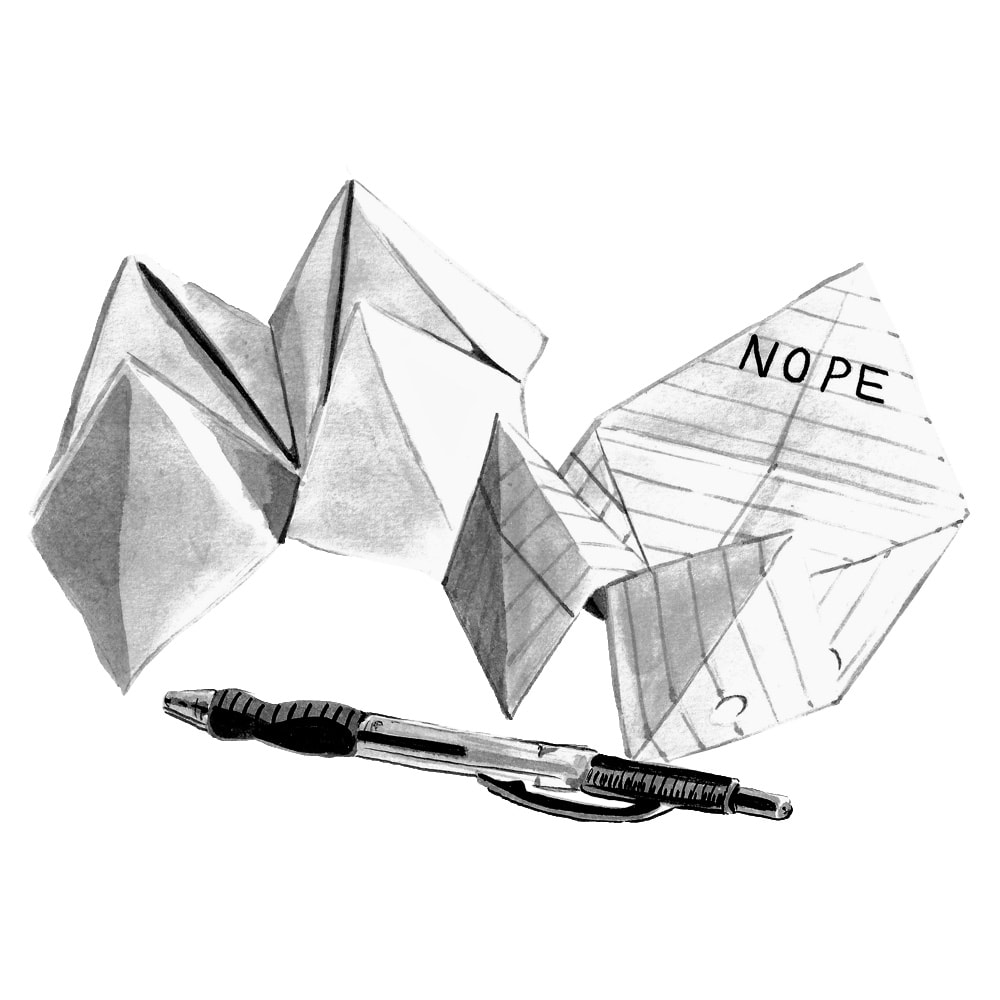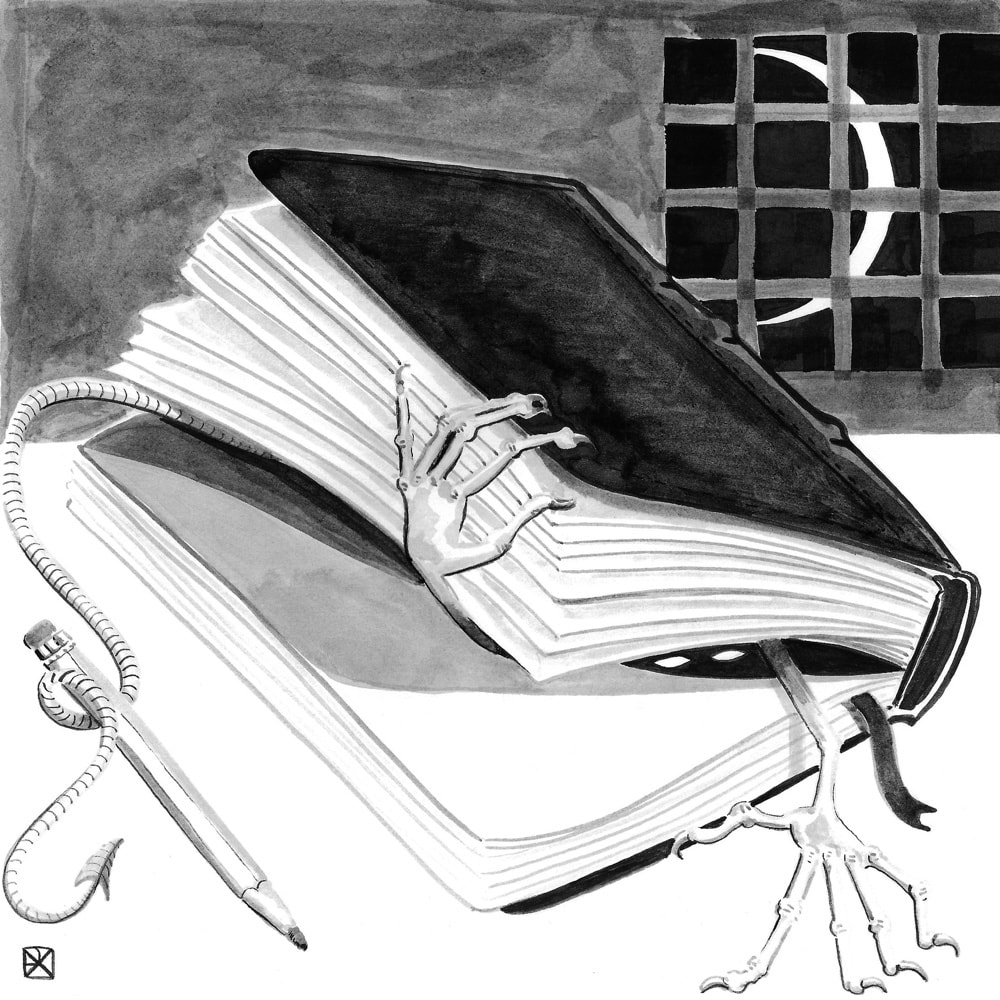This is the fifth and final post in a series on dream journaling. In the last post, I talked about dealing with nightmares and shadow material. Now it’s time to put it all together, interpret your dreams, and review and maintain your journal over time.
1. Don’t Ask Your Dreams To Make Sense
If you expect recording your dreams to pull them into linear, narrative sense, you shall be sorely disappointed. It’s a one-way process of language acquisition. Your dream journal can get you fluent in Dreamish, but it won’t do as much to change the language and style your dreams use to speak to you.
Don’t require logic and order from your dreams before holding space for them, and don’t discard them for coming off eccentric.
Dream journaling works best as a steady practice. If you get something out of the practice as a whole, keep showing up for the weird and obtuse dreams as much as for the crystal clear ones. Per oddity ad astra. It’s a strange and winding road to the clarity.
2. Once More With Feeling
When you suspect a dream holds a message for you, but you can’t pin it down, revisit it through art. After recording it as accurately as you can, re-write the dream as a poem or draw it as an illustration. Musician and dancers could work a dream’s mood through melody or movement.
This second time around, let your waking thoughts and feelings intrude on the dream imagery. What do you add, subtract, and shift around? How does that change the way you see the dream? This exercise is a way of talking to yourself, and making sense of your own inner landscape, so creative license counts.
Your creativity is part of your intuition. Reinterpreting a dream through art bridges the dreaming and waking mind, and can prompt insight on a dream’s symbolism and messages.
Consider using separate iterations for the dream artwork you need to know your own mind and the artwork you share with the wider world. Some imagery may be too personal, ephemeral, or sensitive to share, and some may need multiple rounds of re-interpretation and story building to reach an outside audience with the same emotional impact it had on you in sleep.
If you’re mining your dreams for art, assume they’re half-baked when they get to you, and put in the work to cook them through before you serve them. Set down the final product for a few days or weeks and come back to it with fresh eyes before releasing it to the wild. Show it to a few friends or a workshop group before publishing. Many dreams remix things we’ve seen and heard throughout the day, so double check that you’re not copying forgotten influences too closely!
3. You Can’t Interpret Everything. (And That’s Okay!)
Some dreams will leave you stumped, for days, weeks, years, or forever.
You may have heard the Talmud quote, “a dream uninterpreted is like a letter unopened.” Note that it doesn’t specify what kind of letter. Some dreams read like mystic poetry from a beloved counsellor, some read like ransom notes, and some resist prying fingers only to explode like vengeful packets of shredded newsprint and glitter.
Don’t hold yourself to the impossible standard of neatly and successfully interpreting every dream. Some dreams need to breathe and will become clear in time, but others will stay murky for good, and that’s part of the game.
4. Review Periodically
Re-read over your old dreams once in a while. I like to review my recent dreams weekly, and skim over the years’ dreams once every 3-6 months or so. A few days’ distance freshens the eyes for interpretation. Longterm hindsight helps identify patterns and crossover between your dreaming and waking life. You might even find a few predictive dreams!
5. Take Note
As you review old dreams, add notes and updates to reflect the new thoughts and interpretations they prompt. Date these new notes so you don’t mistake them for the originals.
This is easiest to do with a digital file or a 3-ring binder. If your journal is bound, you can tack in fresh blank pages with a glue stick or tape, or you can photocopy your old dream and paste it into a current entry to add new notes.
6. Waking Life Comes First
Finally, it’s fine to take a break if and when your dreaming practice becomes too stressful or time consuming. Maybe you’ve just had a kid and you’re barely sleeping as is, or maybe work is off the rails and you have to hustle first thing in the morning. Whatever the reason, it’s fine to table your dream journal for a few weeks, months, or even years. You can always pick it up again later.
To be clear, you do still need to sleep. If you stop sleeping, you will lose your mind and maybe die, science isn’t sure. You will def lose your coordination and mood control and start hallucinating. Sleep is not optional. You can survive, however, without lending your sleep-life the extra waking time of writing, reflection, and art.
Do not let anyone make you feel lesser-than for skipping out on a New Agey trend, do not succumb to nocturnal FOMO, and do not fear losing your connection to your dreams. Intuition and creativity flex to fit the time and space you give them, but they never scoot off completely.
You may stop remembering the details, but you won’t stop dreaming. You may go through a re-entry curve, but your recall will pick back up as you pick your journal back up. In the meantime, waking life comes first.
If you expect recording your dreams to pull them into linear, narrative sense, you shall be sorely disappointed. It’s a one-way process of language acquisition. Your dream journal can get you fluent in Dreamish, but it won’t do as much to change the language and style your dreams use to speak to you.
Don’t require logic and order from your dreams before holding space for them, and don’t discard them for coming off eccentric.
Dream journaling works best as a steady practice. If you get something out of the practice as a whole, keep showing up for the weird and obtuse dreams as much as for the crystal clear ones. Per oddity ad astra. It’s a strange and winding road to the clarity.
2. Once More With Feeling
When you suspect a dream holds a message for you, but you can’t pin it down, revisit it through art. After recording it as accurately as you can, re-write the dream as a poem or draw it as an illustration. Musician and dancers could work a dream’s mood through melody or movement.
This second time around, let your waking thoughts and feelings intrude on the dream imagery. What do you add, subtract, and shift around? How does that change the way you see the dream? This exercise is a way of talking to yourself, and making sense of your own inner landscape, so creative license counts.
Your creativity is part of your intuition. Reinterpreting a dream through art bridges the dreaming and waking mind, and can prompt insight on a dream’s symbolism and messages.
Consider using separate iterations for the dream artwork you need to know your own mind and the artwork you share with the wider world. Some imagery may be too personal, ephemeral, or sensitive to share, and some may need multiple rounds of re-interpretation and story building to reach an outside audience with the same emotional impact it had on you in sleep.
If you’re mining your dreams for art, assume they’re half-baked when they get to you, and put in the work to cook them through before you serve them. Set down the final product for a few days or weeks and come back to it with fresh eyes before releasing it to the wild. Show it to a few friends or a workshop group before publishing. Many dreams remix things we’ve seen and heard throughout the day, so double check that you’re not copying forgotten influences too closely!
3. You Can’t Interpret Everything. (And That’s Okay!)
Some dreams will leave you stumped, for days, weeks, years, or forever.
You may have heard the Talmud quote, “a dream uninterpreted is like a letter unopened.” Note that it doesn’t specify what kind of letter. Some dreams read like mystic poetry from a beloved counsellor, some read like ransom notes, and some resist prying fingers only to explode like vengeful packets of shredded newsprint and glitter.
Don’t hold yourself to the impossible standard of neatly and successfully interpreting every dream. Some dreams need to breathe and will become clear in time, but others will stay murky for good, and that’s part of the game.
4. Review Periodically
Re-read over your old dreams once in a while. I like to review my recent dreams weekly, and skim over the years’ dreams once every 3-6 months or so. A few days’ distance freshens the eyes for interpretation. Longterm hindsight helps identify patterns and crossover between your dreaming and waking life. You might even find a few predictive dreams!
5. Take Note
As you review old dreams, add notes and updates to reflect the new thoughts and interpretations they prompt. Date these new notes so you don’t mistake them for the originals.
This is easiest to do with a digital file or a 3-ring binder. If your journal is bound, you can tack in fresh blank pages with a glue stick or tape, or you can photocopy your old dream and paste it into a current entry to add new notes.
6. Waking Life Comes First
Finally, it’s fine to take a break if and when your dreaming practice becomes too stressful or time consuming. Maybe you’ve just had a kid and you’re barely sleeping as is, or maybe work is off the rails and you have to hustle first thing in the morning. Whatever the reason, it’s fine to table your dream journal for a few weeks, months, or even years. You can always pick it up again later.
To be clear, you do still need to sleep. If you stop sleeping, you will lose your mind and maybe die, science isn’t sure. You will def lose your coordination and mood control and start hallucinating. Sleep is not optional. You can survive, however, without lending your sleep-life the extra waking time of writing, reflection, and art.
Do not let anyone make you feel lesser-than for skipping out on a New Agey trend, do not succumb to nocturnal FOMO, and do not fear losing your connection to your dreams. Intuition and creativity flex to fit the time and space you give them, but they never scoot off completely.
You may stop remembering the details, but you won’t stop dreaming. You may go through a re-entry curve, but your recall will pick back up as you pick your journal back up. In the meantime, waking life comes first.










 RSS Feed
RSS Feed
